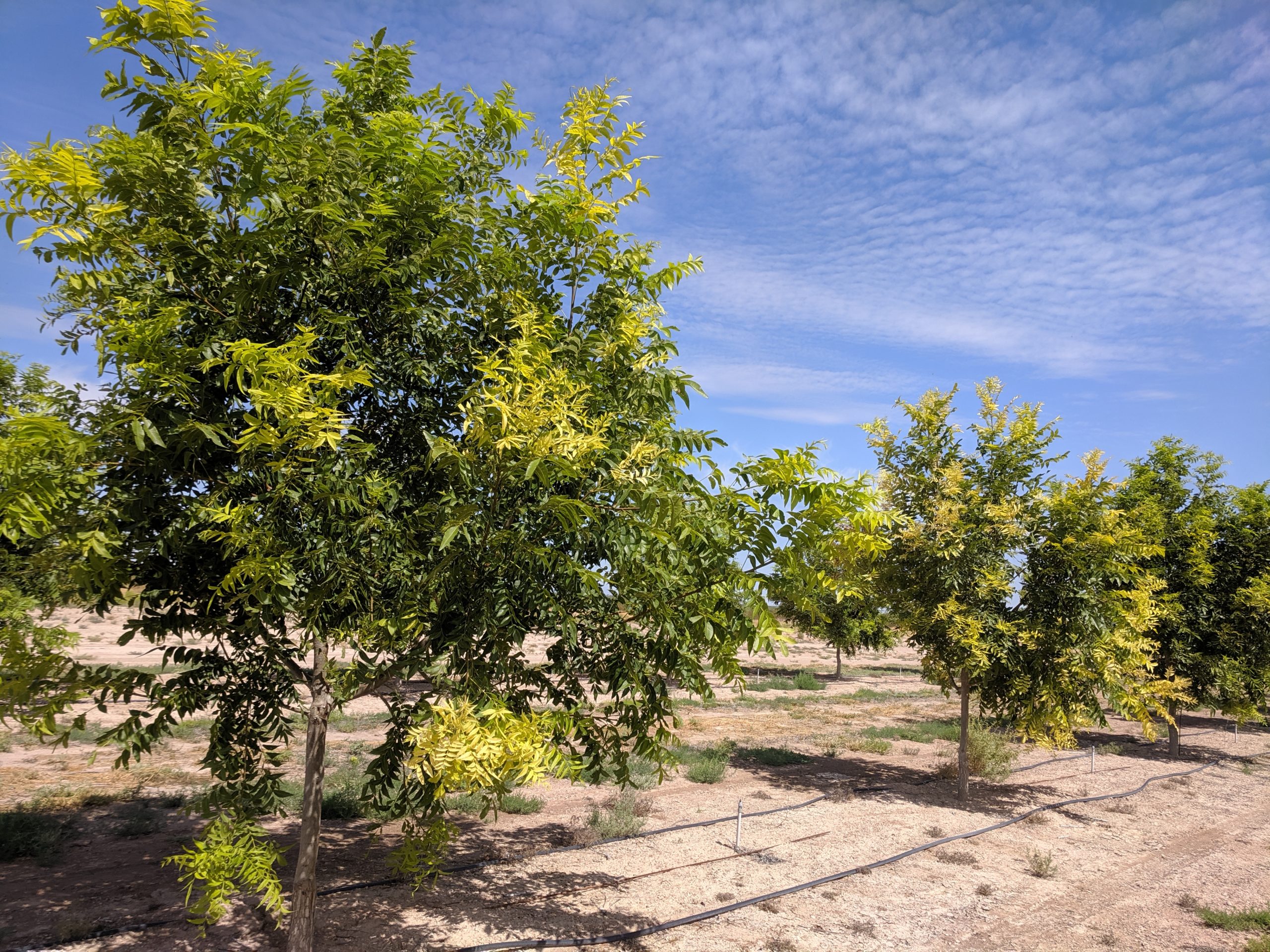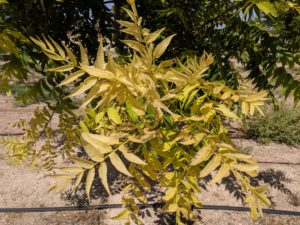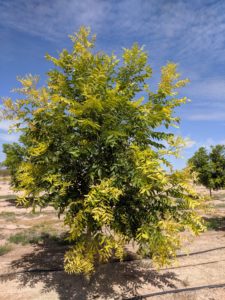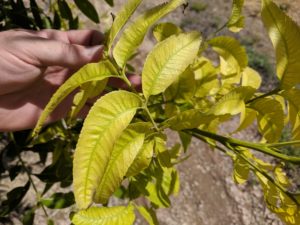Iron—Essential to Humans and to Pecans

At an orchard in San Simon Valley, Arizona, these 'Western Schley' trees show signs of an iron deficiency. (Photos by Joshua Sherman)
Essential Iron
For humans, one major nutrient requirement, iron is essential for is proper blood cell formation, among other functions. For plants, iron is an essential micronutrient (a trace metal) which is primarily required for proper chlorophyll synthesis, among other functions. This primary function is the reason why the lack of iron in a plant creates yellowing of the leaves, or leaf chlorosis. One feature of severe iron deficiency is the distinct interveinal chlorosis, or severe yellowing of the leaf tissue between green veins. Some scientists have indicated to me that they’ve seen iron deficiency so severe that the tissue looked white in appearance.
When I first approached these trees (pictured here) out in the field, I could immediately tell that it was a micronutrient deficiency we were dealing with. Some of you reading this might already know, but I think it’s relevant to the discussion to point out that when yellowing occurs on new growth versus the older growth, it is a tell-tale sign that there may be an element that is not mobilized. Usually, this assumption is the case. It is vice-versa with nitrogen related deficiency and/or elemental interactions; symptoms usually appear on the older plant tissue, inside the canopy.
This level of iron deficiency paired with this severity of symptoms isn’t very common in southwestern pecan growing areas, but it does happen here and there. However, if a tree is exhibiting such iron deficiency as depicted here, one must know that the tree’s carbohydrate production ability is severely limited as well and the pecan fruit and kernel thus negatively impacted. Without the green chlorophyll in the cell there just isn’t much—probably no—photosynthesis occurring.

Suffering from this much leaf chlorosis, this pecan tree will be severely limited in its ability to produce carbohydrates and its pecan fruit and kernel will be negatively impacted. (Photo by Joshua Sherman)
It’s important to point out too that these trees’ iron deficiency is not necessarily caused by soils lacking in iron. Certainly, there were other trees among those pictured here that did not exhibit this severe symptomology of iron deficiency, which warrants more discussion, and I’ll circle back around to. On the other hand, these soils in our western growing regions have a higher pH which causes the available iron (and other trace metals) in the soil to become tied up and bound so that tree roots are unable to take iron up in its usable form. This is why the eastern production regions—unless there’s something else happening in the soil, like anaerobic conditions—typically do not experience iron deficiency like this.
Iron Transport
Currently, no one really knows why some trees exhibit iron deficiency versus others in a rather specific locale, except that possibly the soil conditions change slightly around these affected trees’ roots. For instance, the soil there may have high soil lime and/or a higher soil pH than in the rest of the orchard block. Another theory for this discrepancy between trees is that it is due to genetic expression and these trees’ ability to effectively take up the usable form of iron.
I remember in my graduate research having the opportunity to see old, mature bearing pecan trees in a flood irrigation system, where just one tree in the middle of all these green giants was completely yellow all throughout the canopy. The farm had one or two here and there in the orchard block that really stuck out like sore thumbs. It is possible that just due to the genetic variability of pecan seedling rootstock that these trees just didn’t have the gene turned on to implement an iron uptake strategy at the soil and root interface.
A tree’s ability to take up iron is genetic? That’s right! What scientists have learned so far, and there is still ongoing investigation, is that plants have evolved mechanisms or strategies to specifically take up or transport iron. This, of course, is always a topic of research since, as stated above, iron plays a critical role in human physiology and we want our food sources to contain iron.
However, the overaccumulation of iron within plant cells is not desired either and can lead to oxidative stress within the cells. Plants, therefore, induce an expression of activities to carefully regulate the homeostasis of iron within the cell, and scientists have discovered some of the key players in the signaling pathways that function to induce iron uptake across the plasma membrane. The molecular basis of iron sensing and signaling is ever emerging from scientific research.
Noteworthy here is the knowledge gained by Bruce Wood’s work investigating the interaction of another element in regard to iron. His work found that excessive iron (Fe-DPTA, a chelated iron) would induce nickel deficiency (another trace metal) on ‘Desirable’ seedlings. So, we should keep in mind these interactions with other elements and their ability to have even antagonistic interactions, given that some of these elements have the same charge in their usable form by the plant, thus competing for passage across the plasma membrane. Remembering these interactions is especially important when mixing fertilizers together. Otherwise, one could be wasting their time and money.
Correcting Iron Deficiency
So, if a producer in the West is experiencing some severe iron deficiency where chlorophyll content has been negatively affected, what options do they have to correct this? As we know, the pH of our southwestern soils is mostly above 7.5, therefore it is NOT recommended to soil apply a Fe-EDTA. Rather soil application or fertigation of the iron form Fe-EDDHA around the trees exhibiting iron deficiency should correct the severe chlorosis. Also, a foliar application of amino acid chelated iron is an effective way to correct iron deficiency. However, with either method, it may take a few applications before the chlorosis is corrected. Also note, this is a micronutrient, so it is not used in large quantities in the plant tissue. A little bit will go a long way.



